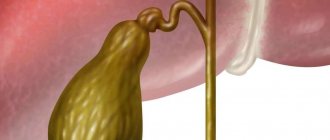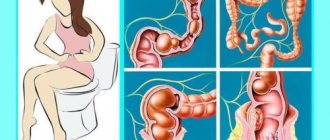Hemorrhoidal pathology is a common, common disease that most often occurs in expectant mothers. The inflammatory process in hemorrhoidal veins begins against the background of pressure from a growing uterus, hormonal imbalance, weakened immunity, constipation, poor diet, and sedentary life. The disease can occur both before and after childbirth due to strong pushing. How to give birth with hemorrhoids?
If hemorrhoids occur before the onset of childbirth, gynecologists recommend that women treat the disease before the onset of labor, and it is best to carry out prevention even before becoming pregnant. How to give birth with existing hemorrhoids? It all depends on the severity of the disease. For example, in difficult situations, women are even subjected to a caesarean section to avoid rupture of the nodes.
Childbirth with hemorrhoids
Natural birth
Most women with hemorrhoids give birth naturally. However, sometimes doctors recommend a caesarean section. Can women give birth with hemorrhoids? There are no medical contraindications. Hemorrhoids and habitual natural childbirth are very common in practice.
The choice of the method of labor is made with the participation of the woman in labor, a proctologist, and an obstetrician. If the risks of complications of hemorrhoidal pathology are small, then the woman gives birth on her own (naturally), since this process is better for the baby.
During childbirth, the hemorrhoidal plexus of veins takes on a large load. In this case, exacerbation, prolapse or pinched nodes may occur. Pinching can occur during the rapid closing of the sphincter after labor. This occurs if the fallen lumps did not hide themselves or the obstetrician did not have time to set them in a timely manner. This happens really rarely.
To avoid complications of hemorrhoids after childbirth, women are advised to properly prepare for the process of giving birth. Learn to breathe correctly, listen to the doctor, behave appropriately during contractions/efforts.
Preventive actions
In order to prevent exacerbation of hemorrhoidal symptoms during pregnancy, as well as during labor, and to avoid complications, pregnant women are recommended to begin treating the pathology at the beginning of its occurrence.
In order to prevent the formation of the disease or its aggravation, pregnant women need to adhere to some simple prevention recommendations:
- lead a mobile, active lifestyle (the level of maximum permissible activity in each individual case is determined by a gynecologist);
- eat properly and balanced, normalize the drinking regime (this will help get rid of constipation and normalize the functioning of the gastrointestinal tract);
- maintain personal hygiene;
- avoid staying in a sitting or lying position for a long time (once an hour, rest should be replaced by 15–20 minutes of activity, for example, walking or light warm-up);
- attend physical therapy or yoga classes aimed at combating hemorrhoids;
- take the knee-elbow position several times a day (this body position helps relieve tension from the pelvic area, minimizes the pressure of the uterus on the large intestine, ensures better blood outflow and prevents thrombus formation in the hemorrhoidal veins).
As auxiliary therapeutic agents, the attending physician may prescribe certain medications, for example, vitamin-mineral complexes or venotonics.
Is it possible to give birth with hemorrhoids? Is it dangerous?
Hemorrhoids during childbirth: what is the best way to give birth? Natural childbirth is not prohibited if hemorrhoids are inflamed, but after childbirth hemorrhoidal complications can occur in the form of:
Specialist doctor
- bleeding;
- infections;
- pinching of cones during prolapse;
- formation of thrombophlebitis;
- acute thrombosis of hemorrhoids;
- necrosis;
- perirectal abscess.
Due to such a rich list of possible complications after childbirth due to hemorrhoids, women are advised to take care of their health in advance by treating the pathology before labor. If you start therapy in a timely manner (at the initial stage of the disease), you will not have to think about how to give birth with inflamed hemorrhoids.
Contraindications for vaginal delivery
Hemorrhoids are not a contraindication to spontaneous childbirth, but they can affect their course to varying degrees. The disease can significantly lengthen the labor period. Also, this process can be more painful for the woman in labor.
Attention! The act of birth itself can provoke an exacerbation of hemorrhoids.
Sometimes, when the fetal head erupts and the anus expands, internal nodes may fall out of the rectum. The main thing here is the prompt reaction of obstetricians, who must quickly move the formation inside before the anal ring closes. This will prevent strangulation of hemorrhoids.
Proper preparation of the woman plays a decisive role in the birth process
A pregnant woman should know how to avoid hemorrhoids during childbirth. To do this, you need to listen to the midwife, do not overstrain the pelvic floor muscles, push only when the doctor says, and breathe correctly.
When performing operative delivery, the load on the pelvic organs and pelvic floor muscles is eliminated, which is preferable in case of severe hemorrhoids. But this does not mean that women who gave birth by cesarean section do not have factors in the postoperative period that contribute to the appearance or exacerbation of hemorrhoids.
Forced bed rest, intestinal atony after surgery, which contributes to the development of constipation, stagnation of blood in the pelvis - all these factors negatively affect the condition of hemorrhoidal veins. Therefore, early activation of the woman in the postoperative period and an elevated position of the pelvis for the outflow of blood from the veins are so important.
Increasing physical activity during pregnancy is an excellent way to prevent hemorrhoids
Hemorrhoids become a contraindication to natural childbirth only if the course of the disease is aggravated by some factors. In such cases, a caesarean section is prescribed.
If in this condition the natural way of childbearing is not suitable, doctors advise refusing conception until the problem is solved by surgical intervention.
If experts allow a natural procedure, this does not mean that it will be completely painless.
It all depends on the professionalism of the obstetricians, who will provide moral and physical support. It is important for a mother in labor to be prepared for the fact that pain during the birth of the baby will increase significantly.
Indications for natural childbirth may include:
- normal course of the disease without prolapse of large nodes;
- absence of frequent bleeding and urge to go to the toilet;
- any non-aggravated form of development (except for the 4th stage);
- absence of possible complications that would complicate delivery.
At any moment, the mother can report unpleasant and painful sensations. In this case, surgical intervention by a surgeon will occur.
Hemorrhoids before childbirth
Carrying a child
Childbirth with hemorrhoids is undesirable, but not contraindicated. However, women need to cure the pathology even before labor. For this, proctologists prescribe various folk remedies, some approved forms of drugs, a balanced diet, an active lifestyle, adequate drinking regimen, and preventive exercises for the muscles in the pelvis.
Pregnant women should avoid constipation, walk a lot, and if an inflamed node appears, carry out timely therapy. You should learn proper breathing, visit a gynecologist and follow all medical recommendations. Not a single woman is immune from hemorrhoidal pathology, so you should contact a proctologist in time to exclude pathological conditions.
If there is constant constipation, you should add laxative products to your diet:
- prunes;
- beet;
- blueberry;
- dried apricots;
- apples and more.
Postpartum activities
Therapy for hemorrhoidal disease in the postpartum period may take the form of:
- conservative (medicinal) treatment;
- surgical intervention (operations to remove hemorrhoidal veins, lumps and nodes).
Conservative treatment of hemorrhoids is based on an integrated approach to solving the problem. In therapy, the use of the following drugs is indicated:
- Venotonics are drugs that can strengthen the walls of blood vessels, restore their elasticity and strength, reduce the level of permeability of the vascular walls and reduce their fragility. The following are highly effective: Phlebodia, Detralex, Venosmil, Venoton, Diosmin, Venoruton, Antistax.
- Local preparations in the form of rectal suppositories, creams or ointments that have anti-inflammatory, strengthens blood vessels and analgesic effects. In therapy, the use of: Hepatrombin G, Relief, Proctosan, Proctosedyl, Anestezol, Posterizan, Procto-Glivenol, Betiol, Nigepan, Ultraprokt, Anuzol, Gemoprost is indicated.
As an addition to medications, the mother in labor is recommended to lead an active (moving) lifestyle, normalize the drinking regime and eat right. All these recommendations underlie the prevention of constipation and congestion in the perianal area, and as a result, the prevention of hemorrhoids.
Modern surgical treatment of hemorrhoids is based on effective and low-traumatic techniques. In most cases, infrared coagulation, sclerotherapy or doping of nodes with latex is used.
It is important to remember that self-medication can not only be ineffective, but also dangerous for both the mother and the newborn baby. Recommendations regarding the treatment of hemorrhoids during the postpartum period are given by a proctologist after examining and interviewing the woman in labor.
Stages of hemorrhoids and their characteristics before childbirth
Childbirth with hemorrhoids is determined depending on the stage of the disease. If the disease is severe, women undergo a caesarean section.
The disease has 4 stages:
Stages of the disease
- 1 – a feeling of discomfort during bowel movements, difficult bowel movements, sometimes with blood loss, hemorrhoidal cones are noticeable only when examined by a specialist. The bumps fall into the lumen only with strong straining during bowel movements, but after the bowel movement they hide on their own.
- 2 – to the above symptoms is added itching, heaviness, nagging pain, radiating to the lower back and sacrum;
- 3 – pain increases, copious discharge appears, hemorrhoidal cones prolapse into the lumen of the anal canal after the process of emptying, lifting heavy bags or objects, then prolapse is observed when coughing or sneezing (the prolapsed cones do not hide on their own, they need to be reduced);
- 4 – a dangerous course of the disease, when the nodes can no longer be adjusted manually, there is a danger of necrosis developing, patients feel unbearable pain, venous thrombosis is possible, heavy blood loss is observed, which threatens anemia.
Features of treatment
Most often, it passes during pregnancy with almost no obvious symptoms, however, when the child is born, it can worsen. Therefore, if it is detected, treatment must be started immediately.
Why does this problem develop in pregnant women:
- Frequent constipation that plagues women expecting a baby is one of the reasons, so first you need to get rid of them. They arise due to poor nutrition, and during pregnancy the chances of constipation increase. The blood in the pelvic area stagnates, hence the problem.
- If the disease manifests itself before childbirth, then the reason for this is hormonal surges. Vascular tone decreases and veins stretch.
- As the fetus grows, the uterus begins to put pressure on the intestines and veins. The outflow of blood becomes worse and stagnation appears.
- The most common reason is the heavy load on the body during childbirth.
- A sedentary lifestyle is a problem for most pregnant women. You definitely need to walk, take walks outside. You can try performing special preventive exercises.
The disease has several stages. As you move to each successive level, the symptoms increase and the disease becomes more advanced.
Stages of hemorrhoidal disease:
- The expectant mother may experience bleeding and discomfort.
- Bleeding continues, and nodes fall out and return to their original place on their own. Additional symptoms include itching and mucus discharge.
- The bleeding also does not stop. Fallen nodes do not return to their place on their own; the help of a doctor is required.
- Nodes fall out all the time. Severe pain, bleeding, and itching appear.
In order to prevent hemorrhoids, pregnant women are recommended to be observed by a proctologist before giving birth and undergo a course of treatment if signs such as a feeling of a foreign body in the anus, itching of the skin, loss of lumps and pain during bowel movements appear. All medications prescribed to the expectant mother are of natural origin and are not dangerous for the baby.
The regime will require a diligent woman to maintain maximum physical activity, walk, and do special gymnastics. Diet is important to prevent constipation. You should not get carried away with confectionery and spicy dishes. The diet should contain enough fruits, vegetable salads, cottage cheese, kefir, and boiled meat.
At the end of pregnancy, the mood of the expectant mother and support depend on close people. Childbirth with hemorrhoids should be entrusted to an experienced doctor. It is necessary to pay attention to the further course of the disease. Do not allow the child to be carried in your arms for a long time. Continue following dietary recommendations.
To reduce the risk of complications at the time of delivery and after it, therapeutic measures should be taken during pregnancy in the first stages of the development of the disease. If hemorrhoids are detected in time, the pathological manifestations disappear before the baby is born. First of all, the expectant mother adjusts her diet to avoid constipation. It is important to include daily physical activity in moderation. In this way, it is possible to increase the tone of the muscles of the rectum and peritoneum.
The doctor prescribes special medications that are approved during childbirth and pregnancy. Before prescribing them, the stage and characteristic manifestations of hemorrhoids are taken into account. If an asymptomatic course of the pathology is noticed, then adjusting the diet and daily routine will be sufficient. When a large hemorrhoid comes out before birth, additional drug therapy is required. For this purpose, the doctor prescribes the groups of drugs shown in the table.
| Action | Name |
| Reduces inflammation and vascular permeability | "Troxerutin" |
| "Troxevasin" | |
| Thins the blood and increases muscle tone | "Eskuzan" |
| "Doxium" | |
| Painful and itchy sensations are eliminated | "Venitan" |
| "Misvengal" |
Many women do not know what to do if hemorrhoids appear during pregnancy. The first rule is not to self-medicate. If you notice the manifestations of the main symptoms of the disease, you should immediately consult a doctor.
An experienced specialist will conduct a consultation based on your specific case and prescribe appropriate therapy. The peculiarity of treating hemorrhoids during pregnancy is that it should not harm the developing baby.
The most dangerous and difficult period for treating a disease in a woman bearing a child is the first three months of pregnancy. Then the fetus is at a developmental stage, and improper medical intervention can cause severe harm. Therefore, doctors do not prescribe pills for hemorrhoids and laxatives.
If you decide to start therapy, you should very carefully select ways to combat hemorrhoids. All medications prescribed by a specialist consist only of natural ingredients. In addition, during this period, local therapy is recommended, for example, rectal suppositories (suppositories) with sea buckthorn oil.
During pregnancy, the effectiveness of the fight against hemorrhoids can be increased by the following factors:
- transition to proper nutrition;
- performing simple exercises.
It is necessary to exclude from the diet foods that do not allow you to get rid of constipation. If you lead an active lifestyle and do light exercises, the blood flow in the venous vessels of the rectum will return to normal. This will allow you to get rid of the disease or minimize its consequences.
How to give birth - useful tips and tricks
Natural childbirth occurs with hemorrhoids under the special supervision of an obstetrician. During labor, the patient may not only lose hemorrhoidal cones, but also experience various exacerbations of the existing hemorrhoidal pathology. For example, pinching. Pinching occurs after childbirth and occurs very quickly. The doctor must carefully monitor the end of labor in order to have time to return the venous plexuses to the anal canal before the sphincter closes, since the bumps do not always hide on their own.
If a woman listens carefully to the obstetrician’s commands, this allows her to avoid not only pinching, but also severe tears during labor, deep cracks, abrasions and other violations of the integrity of the tissue.
Women who lead an active life before pregnancy and during pregnancy rarely encounter hemorrhoidal pathology. If a disease occurs, then after childbirth, the body quickly recovers.
When a pregnant woman is diagnosed with severe hemorrhoidal disease, gynecologists and proctologists recommend giving birth by cesarean section. This happens very rarely, but is not an exception. Thanks to cesarean section, women can avoid hemorrhoidal complications during childbirth.
Prompt assistance during childbirth is necessary for women in labor with stage 4 hemorrhoids, bacterial infection, heavy bleeding from hemorrhoids, and thrombophlebitis.
Causes of hemorrhoids in pregnant women and women in labor
Hemorrhoids during childbirth and during pregnancy are a fairly common occurrence. However, why does its occurrence so often bother women?
The most common causes of hemorrhoids in pregnant and postpartum women are:
- Chronic constipation that occurs due to poor nutrition. The formation of constipation causes stagnation of venous blood in the pelvic area and rectum, and as a result, the occurrence of hemorrhoids.
- An increase in the size of the fetus and uterus, putting pressure on the organs, intestines, veins and arteries of the abdominal cavity and pelvis. All this underlies the occurrence of blood stagnation in hemorrhoidal veins, the formation of thrombosis, constipation and hemorrhoids.
- Maintaining a sedentary, inactive and sedentary lifestyle. Limiting physical activity during pregnancy is one of the mistakes women make, leading to deterioration of blood circulation in the pelvis, the occurrence of hemorrhoids, as well as difficulties during childbirth.
- Changes in the hormonal background of a pregnant woman's body. Pregnancy is a period of restructuring of the body, changes in the amount and ratio of various hormones in it. A sharp increase in the amount of hormones that contribute to the preservation and development of the fetus also leads to varicose veins - in particular in the rectal area, and as a result - hemorrhoids.
- Labor is a period characterized by high stress on a woman’s body and an increase in blood flow to the pelvic area. Against the background of these changes, the emergence (if hemorrhoids have not previously bothered you) or exacerbation of the symptoms of hemorrhoidal disease is observed.
Prevention of hemorrhoids during childbirth
Doctor's recommendations
To avoid hemorrhoidal complications after childbirth, women are advised to take timely care of the health of the anorectal area. It is best to take preventive measures before conceiving a child. The expectant mother should avoid heavy stools and prolonged constipation. If constipation is still present, you should pay attention to your diet.
Dietary nutrition consists of eating foods high in fiber, and it is also recommended to drink 2 liters of water daily. The morning should start with a glass of cool water. Physical activity is important for the health of the female body. It is very useful to visit the pool, run in the morning, and do exercises.
It is forbidden to spend long periods of time sitting in front of a computer or TV. It is useful to walk up to 7 km a day. Personal hygiene should be carried out at least twice a day (morning/evening). Women who have not given birth should take care of muscle tone in the pelvis and perineum; for this, they should perform therapeutic exercises for the anorectal area.
A preventive measure for hemorrhoidal pathology is the knee-elbow position, which should be taken 3-4 times a day, starting from the second half of pregnancy. Such actions help to timely reduce the pressure of the enlarged uterus on the rectal organ. This position helps to enhance the outflow of plasma from the venous plexus of the rectum.
If you regularly perform Kegel exercises, then hemorrhoids will not worsen either before childbirth or after the birth of the child.
Causes of exacerbation of hemorrhoids in pregnant women
Clinical signs of the disease develop in a woman during pregnancy and after childbirth. Causes:
- An unbalanced diet leads to the development of constipation and excess weight.
- Sedentary lifestyle, sedentary work, long periods of standing.
- The presence of pathology of the vessels of the pelvis and lower extremities.
- Hereditary predisposition to the development of chronic venous insufficiency.
If a woman has the listed factors at the time of pregnancy planning or has developed hemorrhoids, she needs to consult a proctologist and undergo a course of conservative and surgical treatment. It is recommended to follow the recommendations of the proctologist - you will avoid the development of exacerbation.
Provoking factors for the development of hemorrhoids during pregnancy
The risk of developing hemorrhoids during pregnancy is due to the following circumstances:
- Endocrine changes in the body of a pregnant woman.
- Physiological changes during pregnancy and childbirth.
- Decreased immune system activity.
- Weakening of muscle and ligament tone due to increased concentration of progesterone in the blood.
- Chronic constipation, accompanied by increased pressure in the pelvis, excessive tension when straining.
- Increased pressure on the intestines and pelvic veins from the growing uterus.
- Reduced physical activity during pregnancy.
During pregnancy, the disease can occur without pronounced clinical manifestations, appearing a couple of weeks before birth or after delivery.










